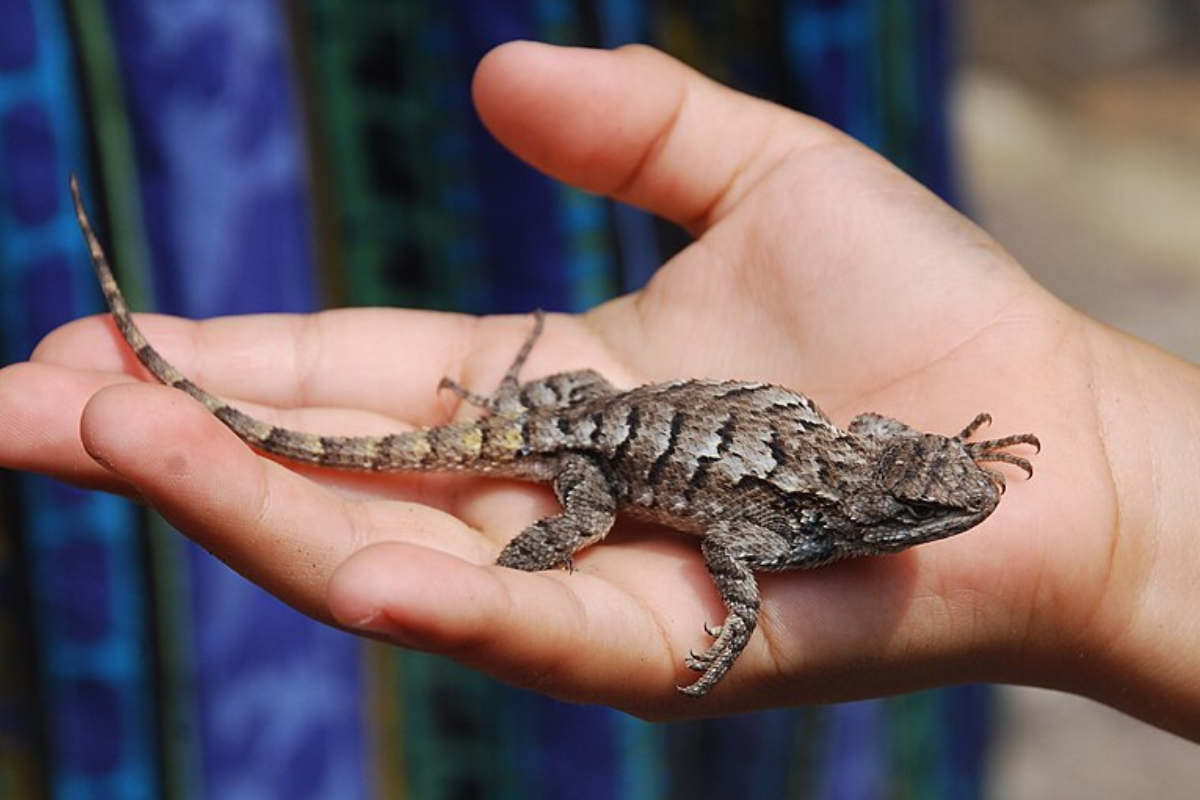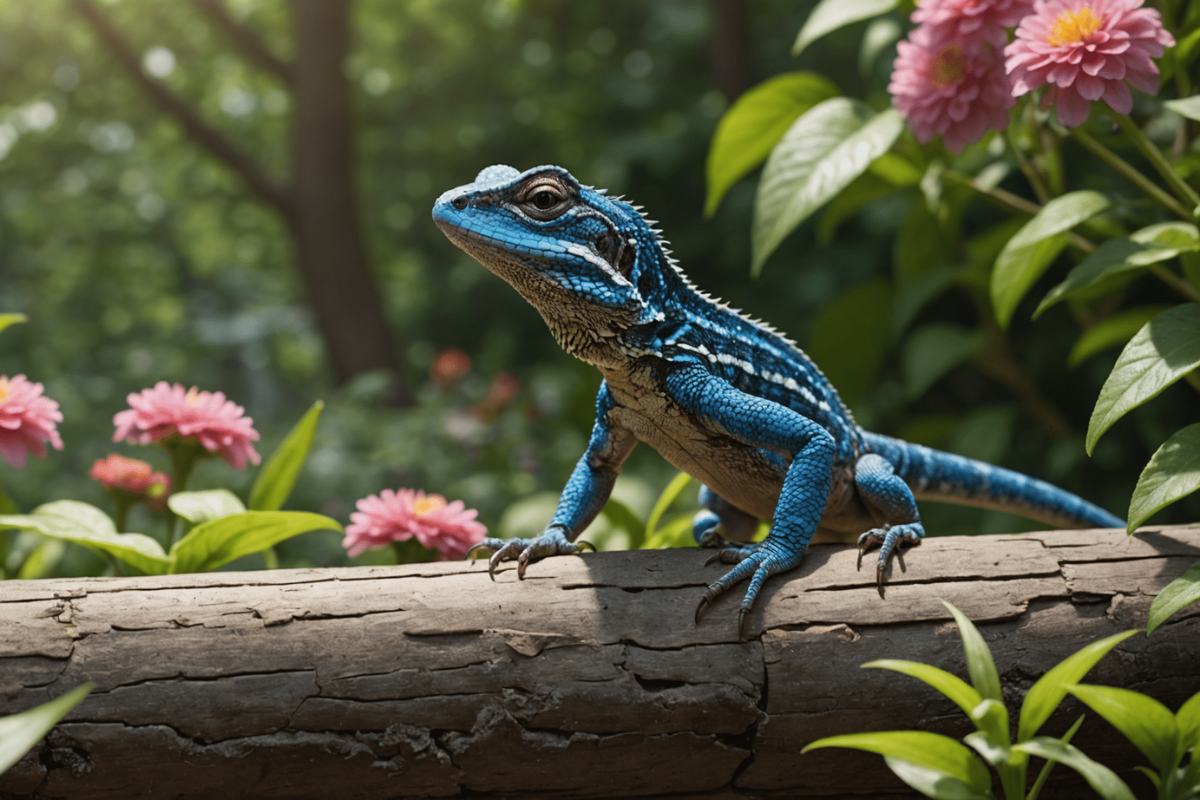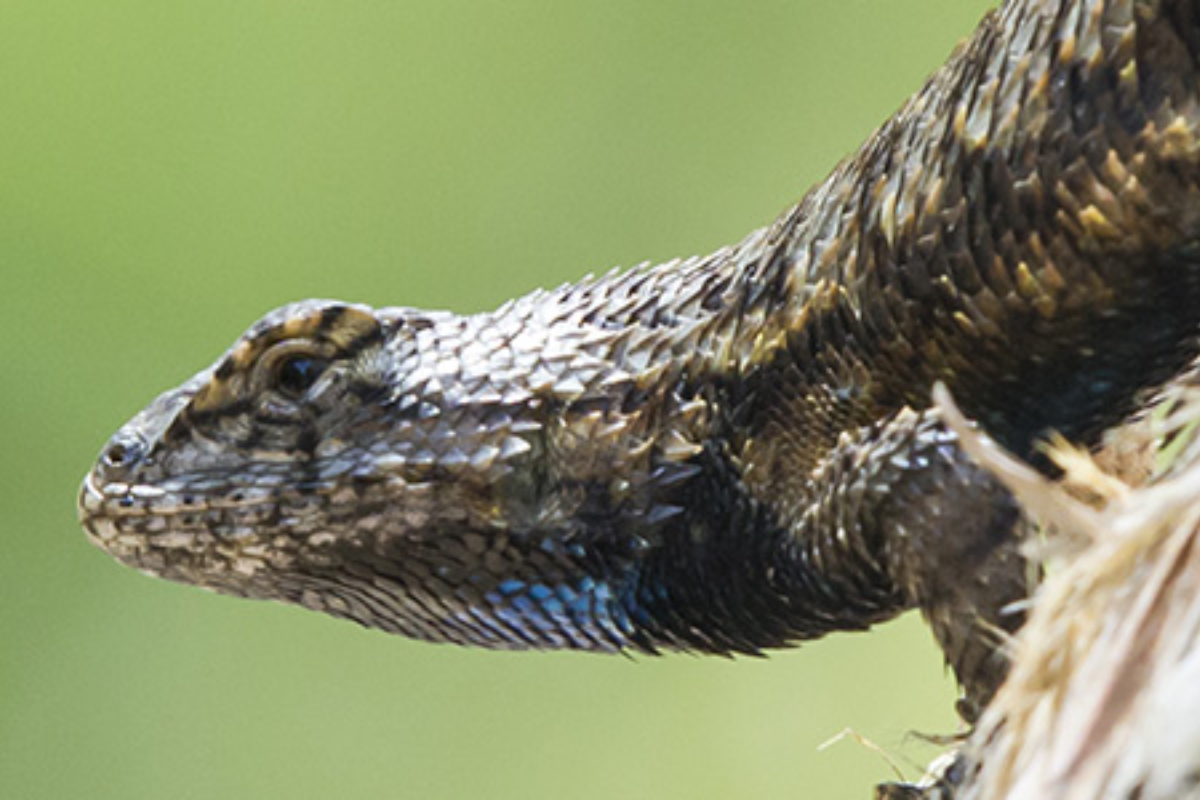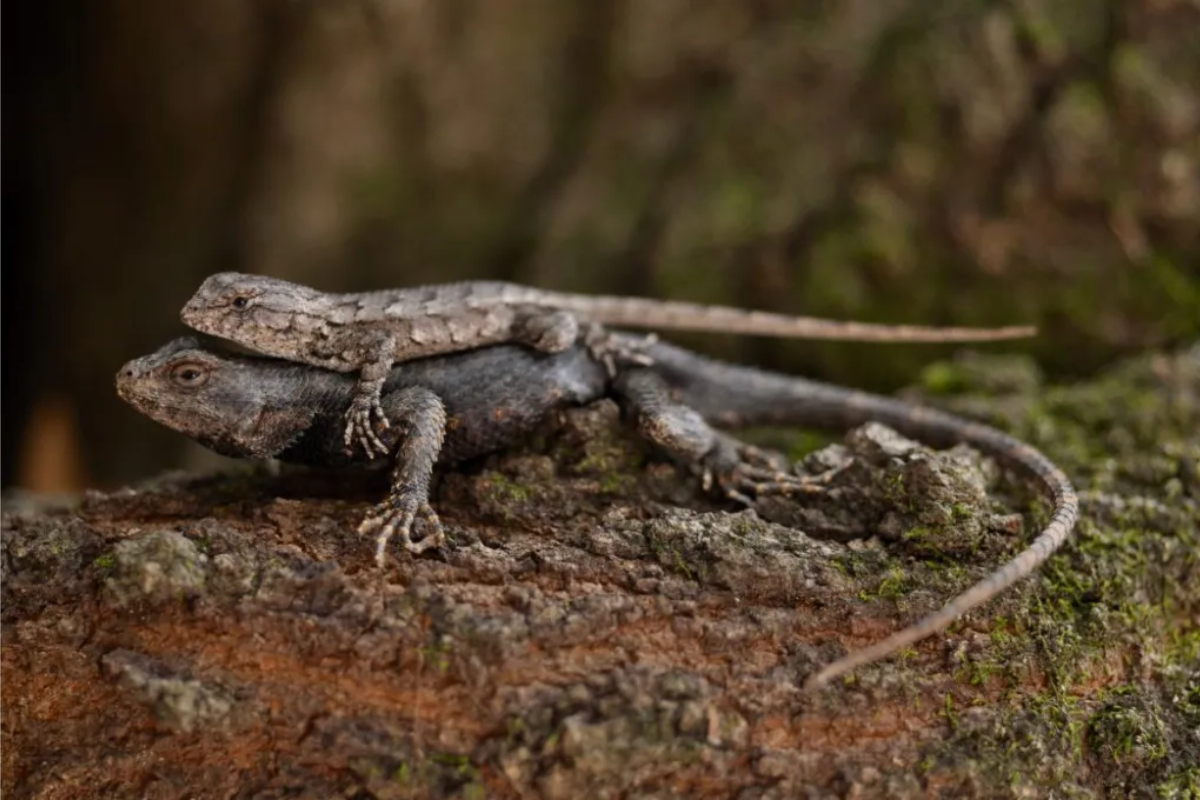An Eastern Fence Lizard is a pet that requires the owner to be familiar with its habitat, feeding, and behavior to be comfortable and happy. This comprehensive guide will take you through all the different aspects of care, beginning with the essentials, such as optimal temperature, humidity, and enclosure design. It will also look into the feeding habits and age-specific optimal amounts of nutrients. It will also deal with health care and some of the issues that the owners may expect to encounter, as well as how to know when to seek medical attention or how to treat the symptoms. Furthermore, knowledge about a given species’ social behavior is essential, in this case, the Eastern Fence Lizard’s typical behavior, which this guide will also discuss regarding handling and environmental enrichment. By the end of this article, readers will acquire the necessary knowledge and resources to effectively set up the environment for their Eastern Fence Lizard and maintain it afterward.
What is an Eastern Fence Lizard?

The Eastern Fence lizard Sceloporus undulatus is a small, scaly, and spiny reproductive lizard most active during the day. They are primarily scattered and distributed across the eastern portions of the United States, the species inhabits forests, rocky regions and woodlands. Eastern Fence lizard, with a size of between 4 and 7.5 inches in length, is sexually dimorphic, with males being more vibrant on the belly and throat patches while females are drab in color. A noticeable characteristic of these lizards is their speed and alertness, employed in their movement patterns. They are said to climb trees and other natural structures during basking and protection. These reptiles are considered good pets due to their capacity to thermoregulate themselves through behavior and their biological restriction of eating insects, making them ideal for reptile fans who want a fascinating but easy-to-care-for animal.
Scientific Name and Classification
The Eastern Fence Lizard falls under the species denoted by Sceloporus undulatus in the Eastern Fence Lizard’s scientific taxonomy done by reptile classification biologists. Like other family members, Phrynosomatidae is classified in Squamata, consisting of lizards and snakes. The Sceloporus genus, known as spiny lizards, is likelier to have keeled scales and notable color pigments on their bodies. With more than 90 other known species within that genus, the Eastern Fence Lizard is ecologically similar to those other species and differing in specific physical characteristics. While this classification system constructs its rank in the trait tree of different reptiles, it also emphasizes structural adaptations that assist the organism to exist in several environments, making it fascinating for herpetologists and people keeping pet reptiles.
Eastern Fence Lizard Physical Characteristics
The Eastern Fence Lizard is a medium-sized lizard that typically measures 4 to 7.5 inches long, with a body covered in rough, spiny scales that aid in camouflage and protection. This species exhibits sexual dimorphism, with males possessing vivid blue patches on the belly and throat, contrasting females’ subtler, brownish hues. The lizard’s dorsal surface is grayish-brown with intricate crossbands that provide a natural concealment against predators. It features a well-defined, wedge-shaped head, robust body, and agile limbs, allowing for proficient climbing and swift movements across rocky and wooded terrains. The vital technical parameters to maintain include ensuring a basking area that reaches temperatures between 90°F to 95°F, with a cooler ambient area around 75°F to 85°F, which supports their ectothermic nature that relies on external heat sources for thermoregulation. Humidity should be maintained between 30% to 50% to adequately mimic their natural habitat conditions. These detailed physical and environmental specifications are crucial for the welfare of an Eastern Fence Lizard in captivity.
Eastern Fence Lizard Facts and Trivia
Whenever I observe Eastern Fence Lizards, I consider them exciting creatures with interesting facts. First, they can escape from predators utilizing a behavior known as autonomy, where they can detach their tails to distract their attacker and avoid being caught. Further, they are avid climbers and can often be seen sunbathing on tree branches and fences, which certainly explains their common name. Males of these lizards increase the blue color of their bodies in mating times to attract females. As for the habitat type, they would be most happy in places that receive direct sun rays and comfortable places to bask, as it is an essential requirement for their thermoregulation. They forage primarily on insects, and in captivity, their diet is supposed to include live food items like crickets and mealworms coated in calcium to avert metabolic bone disease. As stated earlier, all the technical parameters required for their proper maintenance include a controlled terrarium in which the temperature gradient is kept constant. Additionally, climbing structures and hiding spots are to be provided to encourage the natural behavior of these reptiles. All these specifications surrounding the pups ensure they do not have challenges adapting to a captive environment.
How to Create the Perfect Habitat for Your Eastern Fence Lizard

To ensure that your Eastern Fence Lizard thrives in any environment, you must be cautious of how you replicate the conditions in its natural habitat. To begin with, you must invest in the correct size enclosure. Considering their active nature, a terrarium with a minimum capacity of 20 gallons. The substrate material can be a mixture of dirt and sand because they are not clean, have no pesticides, and provide for their burrowing instincts. It is essential to provide a combination of heat and light; a UVB lamp should be utilized to provide critical vitamin D3 synthesis, which allows for calcium metabolism and thus prevents metabolic bone disease. The temperatures should be maintained in the basking area at 90-95 degrees Fahrenheit, and the cool zone should not be less than 75 degrees Fahrenheit and not more than 80 degrees Fahrenheit to allow thermoregulation. Such humidity, as expected in their natural semi-arid environment, typically around 30-40%, should also not be exceeded. Additionally, you can build climbing structures and hides with rocks and branches to provide a more realistic and complex environment. It is advisable to regularly check these conditions to prevent deterioration of the healthy state of these conditions and their overall well-being.
Essential Cage and Setup Requirements
Establishing a cage for my Eastern Fence Lizard, it has come to my attention that the enclosure needs to be quite large, preferably more than 20 gallons,” to enable proper exploration and adequate exercise.” A combination of soil and sand makes the substrate natural since the lizards tend to dig, but it is also nontoxic. It is essential to have good quality lights that produce UVB since these lights enable the production of vitamin D3 necessary for calcium metabolism and help mimic the natural day/night cycle. For important thermal regulation, I keep the basking spot at about 90-95 degrees Fahrenheit so that the rest of the enclosure can be kept at approximately 75-80 degrees Fahrenheit. Another critical point is the humidity, which should be around 30-40%. Since they come from an arid region, it will also be desirable. I add climbing branches and rocks to encourage natural behavior and construct a landscape that encourages climbing and hiding to alleviate stress and promote physical well-being. A thorough inspection and regular flushing are equally crucial in ensuring my lizard lives in a balanced and clean environment.
Proper Substrate and Environment
When determining the suitable substrate for your Eastern Fence Lizard, it’s crucial to replicate the composition found in their natural habitat, which typically comprises a sandy and loamy mix. This combination allows for effective burrowing behavior while reducing the risk of impaction, a common concern with loose substrates. Ensure all substrates are free from chemicals and pesticides to prevent toxicity. Moreover, maintaining a stable temperature range is vital to sustain their ectothermic requirements; the basking area should be kept between 90-95°F, while the cooler regions should range from 75-80°F. Humidity levels must closely mimic their semi-arid environment, ideally within the 30-40% range. Incorporate natural decor such as rocks and branches, providing varied climbing surfaces and hiding spots to minimize stress and encourage natural behaviors. These technical parameters create an environment where the Eastern Fence Lizard can thrive, ensuring a healthy and active lifestyle.
Heating and Lighting: The Importance of a UVB Light
The integration of appropriate heating and lighting systems is paramount for the health and well-being of Eastern Fence Lizards, primarily because it facilitates essential biological functions. UVB lighting is crucial as it aids in the synthesis of vitamin D3, which is vital for calcium metabolism and bone health, effectively preventing metabolic bone disease. It is recommended to use a high-quality UVB lamp, replacing it every 6 to 12 months to ensure optimal functionality. The lighting should simulate a natural daylight cycle, typically providing 10-12 hours of light per day.
Establishing a temperature gradient within the terrarium is necessary for heating. The basking spot should be maintained at 90-95°F, while the ambient temperature in the cooler areas should range from 75-80°F. This gradient allows the lizard to thermoregulate, moving between warmer and cooler zones as needed. Using a basking lamp in conjunction with a thermostat is advisable to ensure temperatures remain consistent and within the specified range. Also, maintaining humidity levels around 30-40% is essential to replicating their natural semi-arid environment. Combining these parameters fosters a habitat conducive to their physiological and behavioral health.
What Does an Eastern Fence Lizard Eat?

The Eastern Fence Lizard is an insect eater, and it needs a live food intake that is quite diverse to cover its nutritional needs. Other basic options include crickets, mealworms, and small roaches of the Dubia variety, which also contain necessary nutrients and proteins. For optimal results, it is suggested to bone the gut-loading live feeder insects at least 24 hours before using them. Supplementing feeds with occasional calcium and vitamin swellings is essential, but it should be ensured that the revisions are not to improve bone growth development as well. Such additives should be sprinkled over the insects to be fed to the lizard before the feeding, and how often this is done depends on the lizard’s age and health condition. However, fresh, clean, and cool water should always be available, while the lizard will probably get most of its moisture from its food. It’s essential to pay attention to feeding behavior and adjust feed volume when necessary about a specific lizard’s activity and growth rate.
Diet in Captivity vs. the Wild
I notice that in captivity, an Eastern Fence Lizard’s diet can be influenced by the abundance and availability of food, which differs from life in the wild. In their natural habitats, these lizards feed on various insects, including beetles, ants, and spiders, thus having diverse diets that promote their overall well-being. In contrast, captivity necessitates using insects like crickets and mealworms that can be easily harvested and come in plenty. Another unique feature of my lizard’s breed is its omnivorous nature; I feed crickets to the tank lizards and put the insects on a liquid diet for around 24 hours before feeding them to the lizards for added nutrition. More importantly, in captivity, there is a need to take calcium and vitamin supplements to correct nutritional deficits and thus enhance bone strength and overall health, both of which they attain naturally in the wild by feeding on diverse prey. Most importantly, these dietary adjustments allow the lizard to emulate the diverse lizard intake that it would have experienced in the wild.
Feeding Schedule: Forage Twice a Day
When feeding my Eastern Fence Lizard, I follow a foraging schedule observed in the field twice daily. Such a regime allows the lizard to remain active as it would be hunting in the wild. Each meal session comprises small portions of live insects such as crickets and mealworms. This encourages the lizard to hunt for food, which is part of its instincts. It is essential to consider how much food is needed and what type is needed to avoid overfeeding the lizard.
Some of the technical parameters that I follow include ensuring that the insects do not exceed the size of the distance between the lizard’s eyes to prevent impaction. Another one is the gut-loading of the insects while being fed to the lizard after twenty-four hours. This is done to enhance the nutritional value of the insects. Calcium powder is dusted over the insects at a frequency of 1 to 2 times a week to aid bone health, and vitamin supplements are administered where necessary. In addition, clean water is freely available, although most of their water intake is from their food. These well-outlined feeding practices will encourage good health and mimic the type of diet in the highly varied wild.
Supplements and Calcium Needs
Addressing the calcium and overall nutritional needs of Eastern Fence Lizards is essential for their long-term health. Calcium, in particular, plays a vital role in preventing metabolic bone disease, a common ailment in captive reptiles. To ensure adequate calcium intake, dust live feeder insects with calcium powder once to twice a week. Additionally, a multivitamin supplement is advisable every week, providing a comprehensive array of nutrients that may be lacking in their captive diet. Technical Parameters: 1) Calcium dusting should occur at least once a week, focusing on juveniles and breeding females who have heightened needs; 2) Choose a balanced multivitamin supplement designed specifically for reptiles; 3) Always provide calcium without vitamin D3 if UVB lighting is in place, and with vitamin D3 if it is not. These measures, coupled with a varied diet, help replicate the nutritional complexity of their natural habitat, promoting vigor and preventing deficiencies.
How to Care for Your Eastern Fence Lizard

Caring for an Eastern Fence Lizard involves consistent attention to their habitat, dietary regimen, and health monitoring to promote longevity and well-being. Begin by ensuring their enclosure remains clean and well-maintained—regularly remove waste and refresh substrates to prevent bacterial growth. Maintain the appropriate temperature, humidity, and lighting conditions as previously outlined, frequently checking and adjusting settings to resemble their native environment.
Regarding diet, provide a balanced mix of live insects and implement a feeding schedule twice daily to simulate natural foraging behavior. Be diligent with calcium and vitamin supplements to prevent nutritional deficiencies, mainly focusing on the needs of developing or gravid lizards. Regularly monitor your lizard for signs of health issues such as appetite, weight, or activity level changes, and consult a herpetological veterinarian for any abnormalities. Furthermore, engage your lizard with environmental enrichment through rearranging climbing structures, which supports mental stimulation and physical activity. Finally, handle your lizard carefully and with minimal stress, respecting their natural behaviors and maintaining their health and comfort.
Basic Eastern Fence Lizard Care Tips
- Enclosure Setup: Ensure an enclosure size of at least 20 gallons for one lizard, with a secure mesh lid for ventilation. Include climbing structures and hiding spots made from rocks or logs to mimic their natural environment.
- Temperature and Lighting: Maintain a basking spot temperature of around 95°F, with the ambient temperature ranging between 75-85°F. UVB lighting for 10-12 hours daily to facilitate calcium metabolism and overall health.
- Humidity Levels: To mimic their arid native habitat, keep humidity between 30% and 40%. Use a hygrometer to monitor levels and prevent excess moisture, which can lead to health issues.
- Dietary Needs: Offer a diet of gut-loaded insects, such as crickets, mealworms, and dubia roaches, dusted with calcium powder two to three times a week. Implement a vitamin supplement weekly to enhance nutritional balance.
- Water Availability: Always provide fresh, clean water, although most hydration will come from their food. Ensure that the water dish is shallow to prevent drowning.
- Health Monitoring: Regularly check for symptoms like lethargy, weight loss, or abnormal shedding. If any persistent symptoms persist, immediate veterinary advice is recommended to ensure prompt treatment.
- Handling and Enrichment: Minimize handling to reduce stress and rearrange enclosure elements periodically for mental and physical stimulation. Offer interactive feeding sessions to engage their natural hunting instincts.
Following these basic guidelines and insights from the top resources ensures a well-rounded approach to Eastern Fence Lizard care, supporting their health and well-being in captivity.
Recognizing Health Issues and When to Visit the Vet
Recognizing health issues in Eastern Fence Lizards requires meticulous observation of their behavior and physical condition. Key indicators of health problems include changes in appetite or weight, irregular shedding, lethargy, and abnormal stools. Should you observe any of these signs, it is prudent to consult a herpetological veterinarian.
Technical Parameters for Health Monitoring:
- Appetite and Weight Changes: Monitor feeding habits and weight regularly. A digital scale can help track weight fluctuations with precision. A sudden decrease in appetite or unexplained weight loss should warrant veterinary attention.
- Shedding Irregularities: Assess shedding cycles, ensuring complete and regular skin shedding. Use humidity monitors to maintain levels within 30-40% to prevent shedding issues.
- Activity Levels: Observe overall activity and energy levels. Extended periods of lethargy or inactivity, without environmental cause, may indicate underlying health concerns.
- Stool Examination: Conduct regular checks of fecal matter for signs of parasites or digestive issues. A professional should evaluate abnormal consistency, color, or the presence of undigested food particles.
- Physical Examination: Perform routine examinations for visible injuries, skin lesions, or abnormalities and note any rapid changes.
- Immediate Veterinary Consultation: Promptly seek advice for persistent symptoms, especially if they appear suddenly or significantly alter the lizard’s typical behavior or appearance.
By implementing these technical parameters into your regular care routine, you can help ensure the early detection of potential health issues and maintain the overall well-being of your Eastern Fence Lizard.
Handling and Interaction: How to Properly Handle the Lizard
Lizards have a unique body structure, creating concern about strain caused by the grip. For this reason, I ensure that I do not sustain it in a stressful way for the Eastern Fence Lizard and myself. I always approach my lizard carefully and calmly. I ensure that both the front of the body and the back are supported. My hands go underneath the chest while the other supports the back legs. I do not rush my movements in any way. As the lizard grows older and becomes more socialized, I make each interaction and handling session longer and longer. I understand that some movements make the lizard uneasy, such as wiggling, trying to escape, etc. In such cases, I remove the lizard from my hands and return it to its disposition. I allow this since the lizard has the right to feel secure and comfortable. I also believe that these regular interactions assist the lizard in developing trust and lessen the chances of me receiving some sort of hostility when trying to handle it.
Understanding the Lifespan and Behavior of an Eastern Fence Lizard

Considering their primary care is well taken, captive-bred Eastern Fence Lizards live up to 5 to 7 years. However, life expectancy may be shorter in the wild due to predation and other environmental factors. These lizards are active during the day and are primarily seen basking and hunting food in hot and sunny environments. Naturally, these brush lizards are territorial, especially males who will bob their heads and perform push-ups to dominate one another and attract female attention. However, passing heat does allow for basking, and passing shade or shelter allows for cooling. Generally alone, these lizards have fascinating social behaviors when mating. Interactions of this nature should be encouraged in captivity as it will help keep them healthy and happy, which is suitable for both the lizards and their owners.
Average Lifespan in Captivity
The survival of an eastern fence lizard in a protected habitat usually lasts five to seven years. Conditions supporting such longevity include a temperature range of 75-85F throughout the day, a basking area of 95F, and a humidity level of around 30 to 40%. Metabolic health can also be supported by providing a balanced diet of calcium-doused insects with vitamins occasionally included. Weight, the presence of any symptoms and any persistent ones to this lizard, in captivity a vet, helps monitor health so that the animal lives longer, even in captivity.
Behavioral Traits: Defend Their Territory
Eastern Fence Lizards use particular spatial behaviors that enable articulating their dominant and breeding status with other males. Especially the male lizard, head-bobbing and push-up movements are often used to portray defense concerning his surroundings. These are made more impressive by the colorful undersides of the visible lizards as the males perform these movements to scare off challengers. The most assertive of them are, however, the females seasonally during breeding areas when hormone levels are at their peak, it seems the most logical for them to go out seeking out a mate.
Technical Parameters for Encouraging Natural Territorial Behavior:
- Space Allocation: Provide ample space within their enclosure, generally a minimum of 20-gallon terrarium for a single lizard, to allow natural territorial expressions.
- Environmental Enrichment: Incorporate natural or artificial structures such as rocks and branches to facilitate climbing and displaying behaviors, offering the lizard opportunities to utilize different levels within the enclosure.
- Visual Barriers: Install hideouts and visual partitions to create distinct territories within multi-lizard enclosures, minimizing stress and potential conflicts.
- Lighting and Temperature Zones: Ensure a gradient of temperatures with basking areas that mimic their natural environment, supporting activity and territorial displays.
- Behavioral Observation: Regularly monitor interactions to prevent excessive aggression, especially if housing multiple lizards, and adjust the environment accordingly. If necessary, avoid access to compromising areas or change the number of lizards within the space to maintain harmony.
By understanding these behavioral traits and accommodating them through well-considered technical parameters, one can effectively manage and enhance the well-being of Eastern Fence Lizards, ensuring healthy social dynamics and naturalistic expressions in a captive environment.
Mating Season and Reproduction
During Eastern Fence Lizards’ mating season, which typically occurs in late spring to early summer, I observe fascinating courtship behaviors driven by hormonal changes. That males become particularly active, displaying their vibrant underbellies and performing push-up motions to court females. Successful copulation often results in the female laying a clutch of 3 to 16 eggs, which she buries in a warm, moist substrate for incubation.
To support successful reproduction in captivity, implementing specific technical parameters is crucial:
- Temperature Control: Maintain ambient temperatures around 75-85°F, basking spots reaching 95°F to simulate the natural conditions necessary for mating behaviors and egg development.
- Substrate Selection: To enable females to dig and lay eggs comfortably and safely, use a moistened, loose substrate such as a mix of sand and soil.
- Humidity Management: Ensure a humidity range of 30-50% to facilitate proper egg incubation. Overly dry environments may desiccate the eggs, while excessive humidity might lead to fungal growth.
- Dietary Adjustments: Offer a diet rich in calcium and vitamins, particularly for females, to support egg production and prevent potential deficiencies.
By identifying and implementing these technical parameters, I can foster an environment conducive to natural mating and reproduction, thereby contributing to the healthy reproduction and sustainability of Eastern Fence Lizards in captivity.
References
Frequently Asked Questions (FAQ)
Q: What size tank is recommended for an Eastern Fence Lizard?
A: A 20-gallon tank is typically recommended for an Eastern Fence Lizard. This size provides enough space for the lizard to move around comfortably and for you to create a proper setup with hiding spots and climbing opportunities.
Q: How can I tell if my Eastern Fence Lizard is male or female?
A: Male Eastern Fence Lizards often show their blue bellies, which are more vibrant than those on females. Additionally, males may become aggressive and display territorial behavior during mating season.
Q: Is it safe to keep a wild-caught Eastern Fence Lizard?
A: While it is possible to keep wild-caught fence lizards, releasing them back into their natural habitat is generally best to avoid stressing them and disrupting local ecosystems. Wild-caught lizards may also carry parasites like botflies.
Q: What do Eastern Fence Lizards eat?
A: Eastern Fence Lizards are primarily carnivores and enjoy a diet of small invertebrates, such as arthropods. You can feed them insects like crickets and mealworms, providing a varied diet for optimal health.
Q: Do Eastern Fence Lizards require a heat lamp?
A: Yes, a heat lamp is essential for Eastern Fence Lizards, as they need a warm environment to thrive. During the day, a basking spot with temperatures between 90 and 100 degrees Fahrenheit is recommended.
Q: How long do Eastern Fence Lizards live?
A: Eastern Fence Lizards can live up to 5-7 years in captivity with proper care. To ensure a long lifespan, it’s important to provide a suitable habitat, diet, and regular health checks.
Q: Can Eastern Fence Lizards be kept with other reptiles?
A: It is generally not recommended to house Eastern Fence Lizards with other reptiles like iguanas, bearded dragons, or chameleons due to differences in habitat needs and potential aggression. Each species has specific requirements that may not be compatible with others.
Q: What should I do if I found a baby Eastern Fence Lizard?
A: If you find a baby lizard, it’s usually best to leave it in the wild, as young lizards can fend for themselves and contribute to their natural ecosystem. If you decide to keep it, ensure you provide a proper setup and diet suitable for a hatchling.
Q: Are Eastern Fence Lizards poisonous?
A: Eastern Fence Lizards are not poisonous and pose no threat to humans. However, like all wild animals, they should be handled carefully to prevent stress and potential injury to the lizard.
Q: Why might my Eastern Fence Lizard be lethargic?
A: Lethargy in Eastern Fence Lizards can indicate improper habitat conditions, such as inadequate temperature or humidity, or health issues like parasitic infections. It’s essential to check your setup and consult a veterinarian if the lethargy persists.
